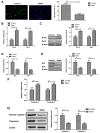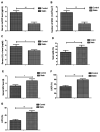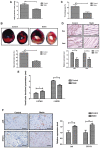Statin rosuvastatin inhibits apoptosis of human coronary artery endothelial cells through upregulation of the JAK2/STAT3 signaling pathway
- PMID: 32582964
- PMCID: PMC7411340
- DOI: 10.3892/mmr.2020.11266
Statin rosuvastatin inhibits apoptosis of human coronary artery endothelial cells through upregulation of the JAK2/STAT3 signaling pathway
Abstract
The purpose of the present study was to explore the potential molecular signaling pathway mediated by the statin rosuvastatin in cultured human coronary artery endothelial cells (HCAECs) induced by CoCl2. CoCl2 was used to induce the apoptosis of HCAECs. Myocardial infarction rats were established and received statin or PBS treatment. Reverse transcription‑quantitative PCR, western blotting, ELISA, TUNEL assay and immunohistochemistry were used to analyze the role of statin treatment. The results showed that rosuvastatin treatment decreased apoptosis of HCAECs induced by CoCl2 by increasing anti‑apoptosis Bcl‑xl and Bcl‑2 expression, and decreasing pro‑apoptosis Bax, Bad, caspase‑3 and caspase‑9 expression. The myocardial ischemia rat model demonstrated that rosuvastatin treatment decreased the mitochondrial reactive oxygen species, inflammation, mitochondrial damage, lipid catabolism, heart failure and the myocardial infarction areas, but improved the cardiac function indicators, right and left ventricular ejection fraction and increased expression levels of Janus kinase (JAK) and signal transducer and activator of transcription (STAT)3 in myocardial tissue. In conclusion, the results of the current study revealed that the statin rosuvastatin presents cardioprotective effects by activation of the JAK2/STAT3 signaling pathway.
Keywords: myocardial infarction; statin; rosuvastatin; apoptosis; human coronary artery endothelial cells; Janus kinase 2; signal transducer and activator of transcription 3.
Figures






Similar articles
-
Myocardial ischemia activates the JAK-STAT pathway through angiotensin II signaling in in vivo myocardium of rats.J Mol Cell Cardiol. 2001 Feb;33(2):307-16. doi: 10.1006/jmcc.2000.1303. J Mol Cell Cardiol. 2001. PMID: 11162135
-
Effect of propofol on myocardial ischemia/reperfusion injury in rats through JAK/STAT signaling pathway.Eur Rev Med Pharmacol Sci. 2019 Jul;23(14):6330-6338. doi: 10.26355/eurrev_201907_18456. Eur Rev Med Pharmacol Sci. 2019. PMID: 31364140
-
Suppression of microRNA-135b-5p protects against myocardial ischemia/reperfusion injury by activating JAK2/STAT3 signaling pathway in mice during sevoflurane anesthesia.Biosci Rep. 2017 Jun 27;37(3):BSR20170186. doi: 10.1042/BSR20170186. Print 2017 Jun 30. Biosci Rep. 2017. Retraction in: Biosci Rep. 2021 Jun 25;41(6):BSR-2017-0186_RET. doi: 10.1042/BSR-2017-0186_RET. PMID: 28522550 Free PMC article. Retracted.
-
Losartan promotes myocardial apoptosis after acute myocardial infarction in rats through inhibiting Ang II-induced JAK/STAT pathway.Eur Rev Med Pharmacol Sci. 2020 Jan;24(1):409-417. doi: 10.26355/eurrev_202001_19939. Eur Rev Med Pharmacol Sci. 2020. PMID: 31957855
-
Rosuvastatin Inhibits Interleukin (IL)-8 and IL-6 Production in Human Coronary Artery Endothelial Cells Stimulated With Aggregatibacter actinomycetemcomitans Serotype b.J Periodontol. 2017 Feb;88(2):225-235. doi: 10.1902/jop.2016.160288. Epub 2016 Oct 14. J Periodontol. 2017. PMID: 27739345
Cited by
-
Regulation of STAT3 and its role in cardioprotection by conditioning: focus on non-genomic roles targeting mitochondrial function.Basic Res Cardiol. 2021 Oct 12;116(1):56. doi: 10.1007/s00395-021-00898-0. Basic Res Cardiol. 2021. PMID: 34642818 Free PMC article. Review.
-
Simvastatin Reduces Doxorubicin-Induced Cardiotoxicity: Effects beyond Its Antioxidant Activity.Int J Mol Sci. 2023 Apr 20;24(8):7573. doi: 10.3390/ijms24087573. Int J Mol Sci. 2023. PMID: 37108737 Free PMC article.
-
Does Concomitant Use of Methotrexate with JAK Inhibition Confer Benefit for Cardiovascular Outcomes? A Commentary.Rheumatol Ther. 2024 Dec;11(6):1425-1435. doi: 10.1007/s40744-024-00721-x. Epub 2024 Oct 14. Rheumatol Ther. 2024. PMID: 39397239 Free PMC article.
-
Inflammatory Pathways in Coronary Artery Disease: Which Ones to Target for Secondary Prevention?Cells. 2025 Jan 21;14(3):153. doi: 10.3390/cells14030153. Cells. 2025. PMID: 39936945 Free PMC article. Review.
-
Rosuvastatin exerts cardioprotective effect in lipopolysaccharide-mediated injury of cardiomyocytes in an MG53-dependent manner.BMC Cardiovasc Disord. 2022 Feb 23;22(1):69. doi: 10.1186/s12872-022-02458-3. BMC Cardiovasc Disord. 2022. PMID: 35196979 Free PMC article.
References
-
- Fan FF, Xu Q, Sun Q, Zhao SJ, Wang P, Guo XR. Assessment of the reporting quality of randomized controlled trials on treatment of coronary heart disease with traditional Chinese medicine from the Chinese journal of integrated traditional and Western medicine: A systematic review. PLoS One. 2014;9:e86360. doi: 10.1371/journal.pone.0086360. - DOI - PMC - PubMed
-
- Tully PJ, Cosh SM, Baumeister H. The anxious heart in whose mind? A systematic review and meta-regression of factors associated with anxiety disorder diagnosis, treatment and morbidity risk in coronary heart disease. J Psychosom Res. 2014;77:439–448. doi: 10.1016/j.jpsychores.2014.10.001. - DOI - PubMed
MeSH terms
Substances
LinkOut - more resources
Full Text Sources
Research Materials
Miscellaneous

